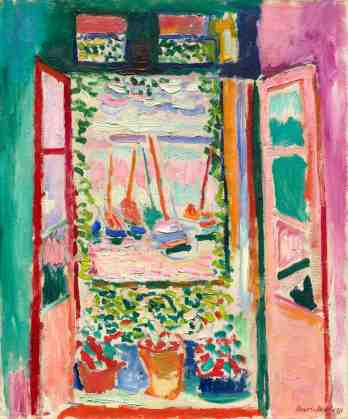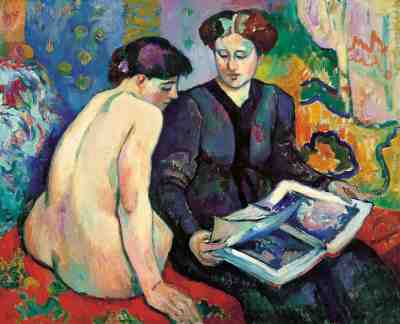by Paula Terán
Vienna, from 20. September 2013 to 12. January 2014
The ‘Fauvism’ is the first and shortest vanguard movement of the 20th century.
It lasted only from 1905 to 1907/08, and was formed by the ‘fauves’ (‘wild animals’ or ‘beasts’), analogy with which the work of a group of young artists was identified at that time.
Henri Matisse (1869-1954) was the head and the leader of the fauves and the Albertina museum is now presenting some of the most relevants works by these artists for the first time ever in Vienna and Central Europe.
The exhibition is showing around 160 works, including not only paintings but also drawings, lithographs, ceramics, glass objects and other sculptural art works.
Matisse and his ‘fauves’ friends, André Derain, Maurice de Vlaminck, Henri Mang, Albert Marquet, Geroge Braque, among others, revolutionised the conception of art at that moment by capturing the nature and the motifs of their paintings, not by imitation but using arbitrarily selected and intensely brilliant colours, sketchy brushstrokes and unmodeled colour areas.
Matisse considered the subject and the background as equal, and did not allow any main subject to become the focus of his works.
The motif was secondary. What counted was expression, and not only in their paintings but also in their sculptures and furniture.

Pond at Ursine near Chaville, 1905, Maurice de Vlaminck. Oil on canvas. Collection Triton Foundation, The Netherlands.
The exhibition gives also great importance to the works on paper of the Fauves, with a particular section dedicated to the drawings and the watercolours.

Seated Nude Combing Her Hair, 1906, Georges Braque. Oil on canvas. Milwaukee Art Museum, United States.
As usual, some useful information for your visit:
- Albertina website: http://www.albertina.at/en
- Dates and opening hours for the exhibition: from 20 September 2013 to 12 January 2014. Monday to Sunday from 10.00h to 18.00h; Wednesday from 10.00h to 21.00h.
- Ticket Prices and Sales: General: 11,90€; students with ID (up to age 26): 8,50€; Children up to 19: free.
****************************************************************************************************************
Museo Albertina: ‘Matisse y los Fauves’, Viena, del 20. Septiembre 2013 al 12. Enero 2014.
El ‘Fovismo’ fue el primero y más breve de los movimientos del vanguardismo del siglo XX.
Se desarrolló entre los años 1905 a 1907/08, y estaba formado por los ‘Fauves’ (fieras), analogía con la que el trabajo de este grupo de jóvenes artistas se identificó en aquel momento.

Still Life with Red Carpet, 1906, Henri Matisse. Oil on canvas. Musée de Peinture et Sculpture, Grenoble.
Henri Matisse (1869-1954) fue el padre y el líder de los Fauves, y el museo Albertina presenta ahora por primera vez en Viena y en Europa central algunos de los trabajos más relevantes realizados por estos artistas.
La exposición consta de unoas 160 obras e incluye no sólo pinturas sino también dibujos, litografías, cerámicas, trabajos en cristal y otras obras de escultura.
Matisse y sus amigos ‘fauves’, André Derain, Maurice de Vlaminck, Henri Mang, Albert Marquet, Geroge Braque, entre otros, revolucionaron la concepción existente del arte en ese momento, capturando la naturaleza y los motivos de sus pinturas, no a través de la imitación de los mismos sino utlizando colores brillantes y seleccionados de manera arbitraria, con pinceladas superficiales y áreas de color no modelado.
Matisse consideraba el tema o motivo prinicipal de la obra y el fondo iguales, sin dejar que el tema principal se convirtiera en el centro de atención de sus trabajos.
El motivo era algo secundario. En los Fauves lo que contaba era la expressión, y no sólo en sus pinturas sino también en las obras de escultura y de mobiliario.
La exposición destaca también la importancia de los trabajos en papel de los Fauves, dedicando una sección específica a los dibujos y acuarelas.

The Girls, 1905/06, André Derain. Watercolor and pencil on paper. Musée national d’Art moderne – Centre Georges Pompidou, Paris.
Como es habitual, aquí se incluye alguna información útil para la visita:
- Página web del museo Albertina: http://www.albertina.at/en
- Fechas y horario de apertura de la exposición: del 20 de septiembre 2013 al 12 de enero 2014.
- De lunes a domingo de 10.00h a 18.00h; miércoles de 10.00h a 21.00h.
- Tarifas y venta de entradas: General: 11,90€; estudiantes (con DNI y hasta 26 años): 8,50€; menores hasta los 19 años: entrada gratuíta.






